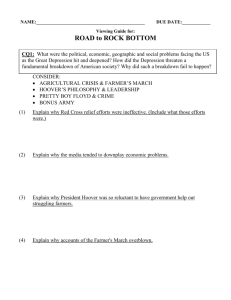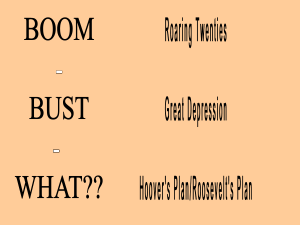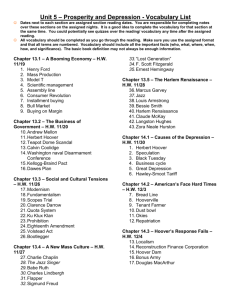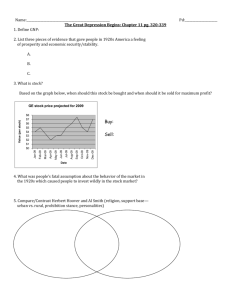The Great Depression: Review Guide US History II Part I
advertisement
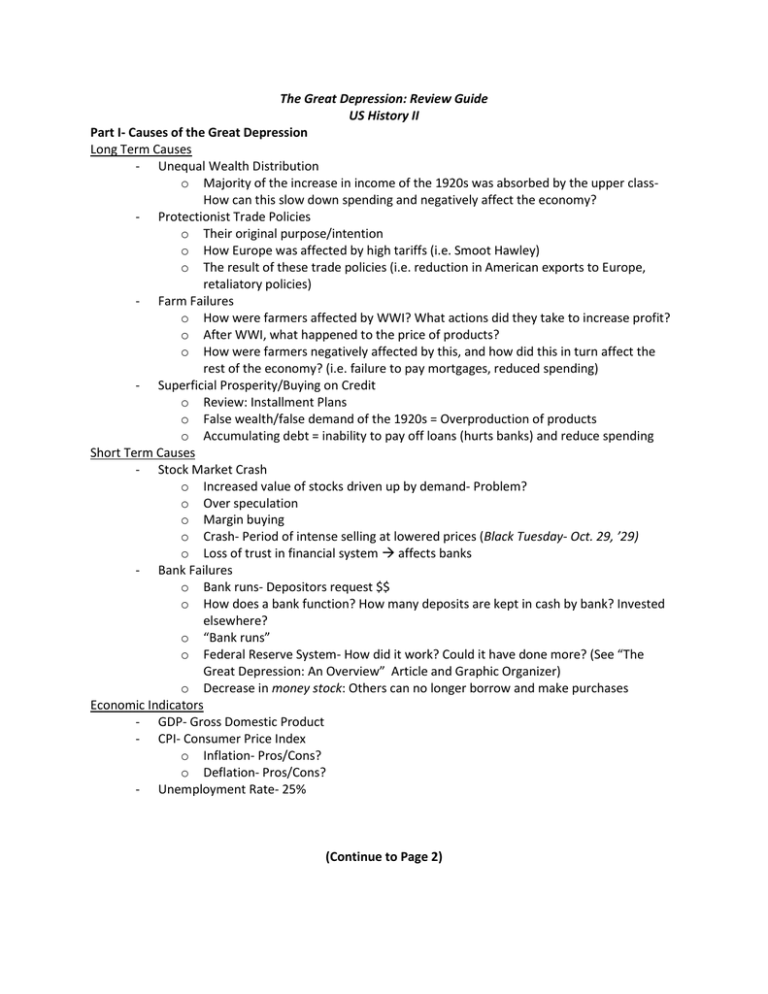
The Great Depression: Review Guide US History II Part I- Causes of the Great Depression Long Term Causes - Unequal Wealth Distribution o Majority of the increase in income of the 1920s was absorbed by the upper classHow can this slow down spending and negatively affect the economy? - Protectionist Trade Policies o Their original purpose/intention o How Europe was affected by high tariffs (i.e. Smoot Hawley) o The result of these trade policies (i.e. reduction in American exports to Europe, retaliatory policies) - Farm Failures o How were farmers affected by WWI? What actions did they take to increase profit? o After WWI, what happened to the price of products? o How were farmers negatively affected by this, and how did this in turn affect the rest of the economy? (i.e. failure to pay mortgages, reduced spending) - Superficial Prosperity/Buying on Credit o Review: Installment Plans o False wealth/false demand of the 1920s = Overproduction of products o Accumulating debt = inability to pay off loans (hurts banks) and reduce spending Short Term Causes - Stock Market Crash o Increased value of stocks driven up by demand- Problem? o Over speculation o Margin buying o Crash- Period of intense selling at lowered prices (Black Tuesday- Oct. 29, ’29) o Loss of trust in financial system affects banks - Bank Failures o Bank runs- Depositors request $$ o How does a bank function? How many deposits are kept in cash by bank? Invested elsewhere? o “Bank runs” o Federal Reserve System- How did it work? Could it have done more? (See “The Great Depression: An Overview” Article and Graphic Organizer) o Decrease in money stock: Others can no longer borrow and make purchases Economic Indicators - GDP- Gross Domestic Product - CPI- Consumer Price Index o Inflation- Pros/Cons? o Deflation- Pros/Cons? - Unemployment Rate- 25% (Continue to Page 2) Part 2- The Great Depression Hardships of the Depression Herbert Hoover - Past experience - Philosophy (see campaign speech: “Rugged Individualism”) - Hoover’s Reassurance- Economic cycles - Hoover’s policies o Boulder (Hoover) Dam o Federal Farm Board o National Credit Corporation o Federal Home Loan Bank Act o Reconstruction Finance Corporation- “Trickle Down” Economics o **No Direct Relief - Anti-Hoover Sentiment (i.e. Hoover flags, Hoovervilles, Hoover blankets) - Mid-term elections (1930) - Gassing the Bonus Army o Patman Bill; Eisenhower and MacArthur Franklin Delano Roosevelt - Brain Trust - Three Main Goals: Recovery, Relief, Reform - “The First Hundred Days” o National Bank Holiday o Emergency Banking Relief Act - Fireside Chats The First New Deal (’33-’35) Second New Deal (’35-’38) Glass-Steagall Act of 1933 “Second Hundred Days” o FDIC Replacement of AAA Federal Securities Act- 1933 Rural Electrification Act Securities and Exchange Commission (SEC) National Labor Relations Board (case against st Prohibition repealed by 21 amendment (1933) Laughlin Steel Corps- Constitutional? Why?) “Alphabet Soup” (See handout and slides): Fair Labor Standards Act o Agricultural Adjustment Act (AAA) **Social Security Act (Frances Perkins) o Tennessee Valley Authority (TVA) Works Progress Administration o Civilian Conservation Corps (CCC) National Youth Administration o Public Works Administration (PWA) o National Recovery Administration (NRA) Criticism and Supreme Court Reaction (i.e. NIRA; AAA) FDR’s response - **Local Relief Contributions (i.e. Hohokus elementary school) - Eleanor Roosevelt - Dorothea Lange - African American Advances - Culture during the Great Depression - Legacies- Expansion of Gov’t Power; Social Security and other federal programs to provide relief that are still intact today - Effect of WWII on Depression


